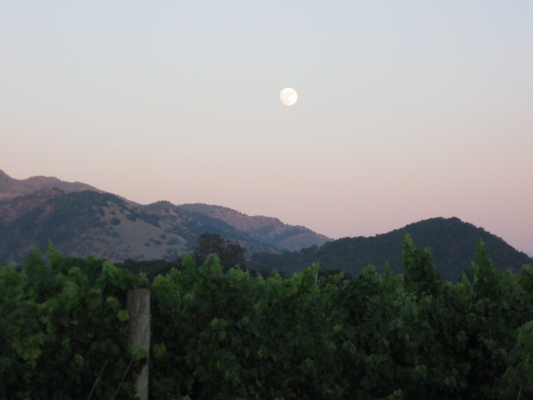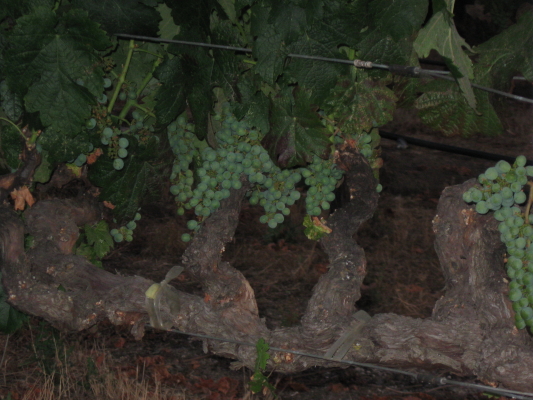Jul 05 2009
An Ode to “White Whales” and How to Capture Them

I sit here on a quiet late evening. The windows of the house are open; a cool summer night breeze is gently floating in and keeping me company. My neighborhood is silent as if to imply that the whole world is soundly sleeping and completely unaware of what I am doing.
In my wine glass sits a 2005 zinfandel: to date, this zinfandel is without question my favorite. The bouquet on this wine is so boldly aromatic that I do not have to bring my nose any closer than one foot from the rim of the glass to catch the hypnotizing smell of freshly made strawberry preserves. As I take a sip in breathless anticipation, my palate is not disappointed. Those same strawberry preserves found on the nose wash across my palate like a rich, sweet wave with depth and power. As I swallow and the finish continues to linger, I am torn between characterizing my feelings as guilt or sheer unadulterated enjoyment.
How could a wine like this possibly present a sense of guilt?
More importantly, what on earth am I drinking and where can you find it?
There is a simple, singular answer to both of these questions: You cannot buy this wine any more because it is no longer produced.
But how can a wine that is so explosively sensual no longer continue to be made?
The mere notion of this wine’s extinction flies in the face of common sense because surely a wine like this would be a winery’s top selling wine. In the case of this wine, its fate is a sad, dramatic tale which is perhaps worthy of being a soap opera titled “As the Grape Vine Withers”. Regarding this zinfandel, the winery in question previously would purchase the grapes from a grower in Napa Valley. That relationship was great . . . until the grower and his wife’s relationship crumbled and they decided to divorce. Once the divorce proceedings were underway, the couple became bitter. Given that the land where the grapes are grown is an asset for the couple, bitter feelings overcame reason: the couple elected to allow the grape vines to die so that neither one of them could obtain them. The result was that the winery no longer could obtain these specific grapes and we, the public, were denied an otherwise extraordinary wine.
Any avid connoisseur of wine would scream with heartbreaking frustration over the above tale. I am fortunate enough to have four bottles of this gem left in my collection. However, I am never a fan of drama or gossip. And as I sit here tonight, quietly sipping on my “last of its vintage” wine, I find myself mildly resentful towards that grower. Why? My answer is simple: indirectly, I have been dragged into this grower’s drama and now have my own dilemma. Aside from hoarding my four bottles, I am torn with every sip: (a) is this wine too delicious to enjoy by oneself or (b) what if I share this wine with someone who cannot appreciate it and then waste it?
Some of you in my audience may have no idea what I am talking about. Others of you might find a tear in your eye at this moment and fully identify with me. I am not looking for sympathy. On the contrary, I am quite lucky that I have my four bottles. And rest assured, I will thoroughly enjoy them. However, the sharing of this sordid tale may help you learn how to recognize these proverbial “white whales” and how to stock your wine collection so that you are not heartbroken later if you find out that your beloved wine is no longer produced.
Why do I refer to a wine such as this zinfandel as a “white whale”? As you appreciate and enjoy wine, you find some wines that are seemingly “larger than life” as they find their way from the bottle, to your glass, and ultimately to your palate. But who are we kidding? Wine is expensive. For most, it is a luxury. As connoisseurs, we try to embrace a modicum of responsibility and to buy only a bottle or two here or there: a practice which is smart and recommended. Most of the time our favorite wines are religiously made by the vintners and we can go back each year and buy another bottle or two to restock our collection. However, when a vintner is buying grapes from growers (as opposed to using estate grown grapes) there is the risk of that wine falling to a near unimaginable demise. And particularly in today’s economy, where you might be tightening your wallet, this risk increases because wineries are tightening theirs as well. And when that happens, certain wines can become too expensive to make and will disappear. These “larger than life” wines, despite their popular following, will be here one day, not be here the next and suddenly no longer be made. They in essence become “white whales.”
Do you need to panic? You never need to panic. Instead, you need to embrace confidence as a knowledgeable wine connoisseur and ask intelligent questions when you are wine tasting (or call the winery directly about wines that you deem exceptional and special):
1) How many cases do they have left and are they at risk of selling out?
2) Where are the grapes grown? Depending on the type of wine that you are inquiring about and the year that it was made, are they going to release the same wine next year or will this be their final distribution?
3) If they are producing the wine for another year, is there any risk of the wine not being produced going forward?
Purchasing wine is commonly referred to as an “investment”. If you know (i) that the wine in question is an absolute favorite, (ii) that it will age well in the bottle, and most importantly, (iii) that you can store it properly, then you need to strike a balance between what you feel comfortable having in your collection and what you want to spend. I have found that wines that I dearly love age wonderfully and continue to knock my flip-flops off each year thereafter.
So what does this mean for me and the zinfandel that I am quietly hoarding? I have four bottles. I honestly wish that I had six bottles in my collection. Then, I would feel more comfortable sharing the wine with others and taking the risk that it may be absolutely lost on them. Because, after all, wine is meant to be enjoyed and part of enjoying a beautiful expressive wine is to share it with others.
Do I know of other stellar wines that may go away? Yes. Have I made my investment? Yes. Will I let you in on what some of these gems are? Yes. In fact, I will be writing about some of these potential “white whales” in upcoming articles. There is no need to worry: stay casual and moreover, stay tuned.

*Want to know what easy appetizer I paired with the last glass of this mystery zinfandel over the weekend? Check out The Casual Connoisseur’s Fan Page on Facebook to find out and see photographs.
Comments Off on An Ode to “White Whales” and How to Capture Them